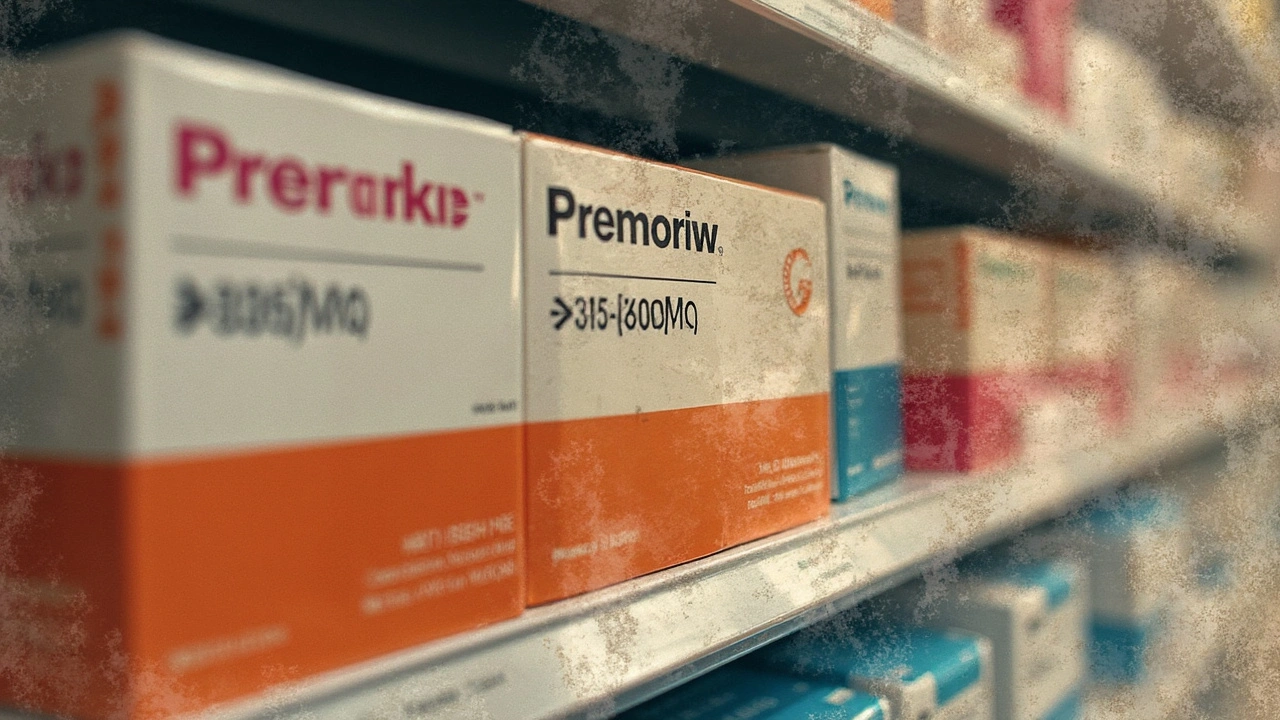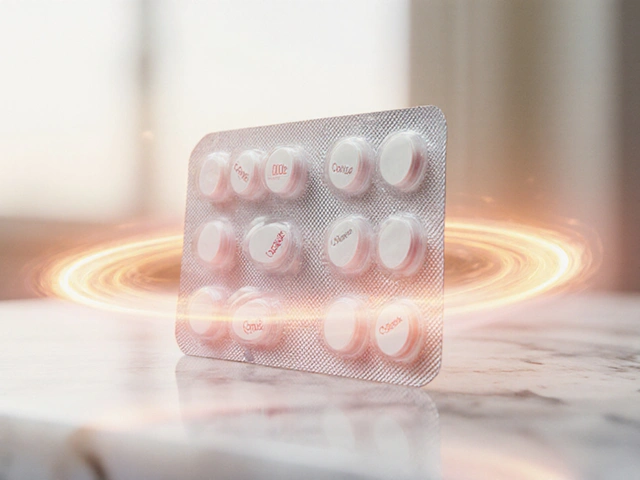Premarin Uses, Side Effects & Alternatives: Hormone Therapy Insights

People talk a lot about menopause, but not many folks actually dig into the details of what women go through when hormones suddenly do a disappearing act. Sure, there’s the hot flashes and the night sweats—the stuff punchlines are made of—but being honest, the reality isn’t a joke. My mate’s mum once described it as a volcano living in your chest, ready to erupt at the worst possible time. Into this chaos comes something called Premarin.
You might have heard the word but didn’t know what it meant. It’s actually short for “pregnant mare’s urine”—literally, because that’s where the original estrogen in the drug was sourced. Sounds a bit mad, right? But when the whole point is getting those lost hormones back, desperate times call for desperate measures. Millions have trusted this medicine since doctors started prescribing it back in the 1940s. Whether you’re going through menopause yourself, have a loved one wrestling with the changes, or just want to know what’s going on with your body (or your partner’s), digging into Premarin opens up a lot of surprising information.
What is Premarin and How Does It Work?
Let’s be real—no one dreams about medical textbooks, so breaking down the basics helps. Premarin falls under hormone replacement therapy (HRT). It’s packed with estrogens (mainly conjugated equine estrogens, for the curious), created to fill the gap when your ovaries stop doing their job. The drop in estrogen is at the core of most classic menopause symptoms. At its simplest, Premarin’s role is to sneak in and balance that out.
What takes Premarin apart from other hormone meds, believe it or not, is the source. The process started in Canada and the US in the 1940s, where researchers figured out that urine from pregnant horses was loaded with usable estrogens. Now, with newer lab techniques, the production’s a bit more sophisticated, but the backbone remains the same. The medicine comes as tablets, creams, or injections, depending on what the doctor thinks is best. Some women use it short-term to get through the worst menopause storms, while others continue it for years—though this is more about weighing risks versus rewards every step of the way.
Doctors don’t just hand out Premarin for hot flushes. It’s also used for stuff like preventing osteoporosis when bones get extra fragile after menopause, and as part of gender-affirming hormone therapy for trans women. Some even prescribe it if a woman’s ovaries were taken out young, almost as a replacement part.
Recent numbers from the Australian Institute of Health and Welfare showed an estimated 300,000 Aussie women used some form of HRT meds in 2024, with Premarin holding a solid chunk of that. It’s clear that people keep turning to hormone therapy for answers, even as debates rage online and in hospital corridors. And while estrogen’s reputation has shifted over the years (especially after big studies like the 2002 Women’s Health Initiative), plenty of GPs today still see it as the gold standard—at least, if the risks are managed carefully.
The bottom line? Premarin works by giving the body back some estrogen, making life a lot more liveable for people caught in the crossfire of hormonal chaos. But it’s not a miracle, and it’s definitely not risk-free. Each dose is a balancing act—relief weighed up against possible downsides.

Benefits, Risks, and the Real Cost of Premarin
When people start asking about Premarin, the top question thrown around is: ‘Will this stuff actually help?’ Moments after that comes the worry: ‘And what could go wrong?’ So, here’s the real-talk breakdown. On the plus side, for many women, Premarin squashes menopause symptoms. We’re talking about fewer sweats, calmer moods, better sleep, and, quite often, sex that doesn’t feel like sandpaper. Vaginal dryness? That tends to clear up pretty fast with estrogen treatment. Bones get love, too: estrogen helps slow down the drop in bone density, which keeps breaks and fractures at bay. For many, that means more active years ahead.
But, and it’s a big but, no medicine comes for free. The long-term risks of hormone therapy all revolve around how estrogen changes the way your body works. Some studies (like the Women’s Health Initiative in the US) flagged up that certain women had a higher risk of heart disease, strokes, blood clots, and breast cancer if they used estrogen for too long or at high doses. The numbers didn’t send everyone running for the hills, but doctors started taking a lot more care with who should use HRT—and for how long. These days, the advice is clear: lowest effective dose, for the shortest possible time.
Another real-life thing to talk about is side effects. Not everyone gets them, but you can’t ignore the possibility. Here are the most common ones women have reported, based on data from both clinical trials and regular GP visits:
- Breast tenderness
- Headaches
- Bloating
- Nausea
- Spotting or changes in periods (for those not fully through menopause)
- Leg cramps
- Mood changes
A few get allergic reactions or skin rashes. Others complain about weight gain. Rare, but not impossible, are clotting problems—so anyone with a history of blood clots, heart attack, or some liver conditions should steer clear without a doctor’s close supervision.
People often ask, “What does it cost?” In Australia, if you have a Medicare card, Premarin falls under the PBS (Pharmaceutical Benefits Scheme), which brings the monthly cost down to something manageable—usually under $30 unless you’re on a special version. Without support, it’s pricier, sometimes pushing close to $80 per month. Still, compared to missing work or the cost of treating osteoporosis or depression caused by hormone crashes, loads of women say it’s a decent trade. For those in rural areas or managing multiple prescriptions, things can get tricky, so talking to your chemist is always a smart move.
If you like crunching numbers, here’s an example table using figures from 2024 stats in major clinical studies and health insurance data:
| Outcome / Risk | Women on HRT (per 10,000) | Women not on HRT (per 10,000) |
|---|---|---|
| Heart Disease | 31 | 29 |
| Breast Cancer | 38 | 30 |
| Stroke | 29 | 21 |
| Hip Fracture | 10 | 15 |
See what stands out? Risks do go up, but for some, those hip fracture stats are just as serious as the cancer or heart numbers. Every woman has her own tipping point. That’s why those chats with doctors do matter—they help you figure out where you’re most at risk, and what matters most for you or your family. By the way, keep in mind that risks also swing wildly depending on your genes, lifestyle, age at starting HRT, and whether you also use progestin (if you still have your uterus, you need this add-on to avoid extra cancer risks).
I’ve heard from friends’ mums who say Premarin gave them their life back, and others who lasted only a month before ditching it. It often comes down to personal tolerance, expectations, and willingness to try other fixes if this one’s a non-starter.

Tips, Alternatives, and Real-World Advice for Women Considering Premarin
If you’re sizing up Premarin for yourself, or for someone you care about, the flood of opinions can get overwhelming. It’s not just about side effects or price. For plenty of women, the idea of putting horse-derived hormones into their body just feels off. This is where knowing your options makes everything a bit less stressful.
First, you’ve got to talk to your GP. That’s not just a box to tick—every doctor worth their salt will walk through your medical history, family stories (especially around cancer, strokes, or clots), and your must-haves versus nice-to-haves. If you get a script, you’ll be seeing that doctor again regularly, not just once, so make sure you’re comfortable asking questions. Think of your first appointment as a planning session, where nothing’s off the table.
Sometimes, doctors suggest trying non-hormonal fixes before (or instead of) HRT. Here are some choices that work for a fair chunk of women:
- Antidepressants like SSRIs or SNRIs (small doses) can help with hot flushes—even if mood isn’t the main issue.
- Gabapentin or clonidine: these are oddballs, but have shown to reduce night sweats.
- Over-the-counter creams and lubes for vaginal dryness, sometimes as good as the fancy scripts.
- Herbal products like black cohosh—though real evidence is mixed and some have nasty side effects when used long term.
- Regular exercise, loads of water, and avoiding caffeine show up in almost every medical study as helpful (though not always enough alone).
If you want hormone therapy but the horse connection is a major turnoff, there are ‘synthetic’ options. Newer meds like estradiol are made in the lab—no horses required. Some brands now use plant-based chemicals cleverly converted to act like estrogen. These can come as gels, patches, nose sprays, or pills. Lab-made estrogens usually cause fewer allergies and suit more people with dietary restrictions.
One natural question is, “How long can I stay on this?” Most guidelines in 2025 say keep it short—ideally, three to five years at most. But loads of real-world patients, and their GPs, stretch this rule if the benefits keep showing up and checkups don’t reveal new risks. Always check in yearly; hormones aren’t ‘set and forget.’
Then there’s what I call the partner effect. Being honest, when my mate’s partner started HRT, their life turned inside out—for the better. Less yelling, more sleep, less worry that she’d collapse at work or burst into tears in the supermarket. Best tip? Learn as much as you can as a couple or support team. Nobody black-and-whites this stuff—it’s all about personal stories and adjusting as you go.
The future might even hold cleaner, cheaper, or more personalised HRT. There are clinical trials in Melbourne hospitals now using skin patches with precision doses, and others exploring micronized progesterone (which may lower the unwanted side effects). If you want updates, check with your GP or look up the Australian Menopause Society for trusted fact sheets.
Final hack? Keep a diary. Track your symptoms, moods, and any side effects week by week. When it’s time for a return appointment, you’ll have real ammo to help tweak your treatment. And don’t miss out on sharing with peers—local Facebook groups and community clinics often get the best tips from those already walking the walk.
Premarin has been around for almost a century now. It isn’t magic, but it’s also not the villain some headlines make it out to be. At the end of the day, everyone’s menopause journey has a different map. Whether you’re chasing less sweat at night or just wanting to feel more like yourself, choosing the right treatment is never a one-size-fits-all deal. Keep your questions sharp and your support team even sharper—you’ll be miles ahead in making the right call.









This is a pretty thorough introduction to Premarin and hormone replacement therapy, but I have a few questions. How does Premarin compare in effectiveness and safety to newer HRT options? I've heard some conflicting info about risks like blood clots and breast cancer—what's the latest consensus on that? Also, the article mentions non-hormonal alternatives. Could someone elaborate on what those are and when they might be preferable?
I'm really curious about patient experiences too. Are there any common themes or surprising things people have noticed while on Premarin? It feels like this topic is super complex, and personal stories would really help in understanding the pros and cons more deeply.
Would love to hear thoughts, especially from those who have firsthand experience or medical expertise.
I appreciate the clarity in the article regarding Premarin’s uses for menopause symptoms. It definitely outlines the basics well without overwhelming with jargon. One important thing people should keep in mind is monitoring side effects closely and having regular check-ins with their doctor.
From what I understand, the side effects can range from mild, like nausea or headaches, to more serious ones requiring immediate attention. Also, it’s always good to talk about lifestyle factors that might affect hormone therapy results. Exercise, diet, and stress levels can influence how effective the treatment feels.
Overall, this is a helpful primer, but anyone interested should definitely dive deeper into each section with a healthcare professional involved.
Okay, I gotta say, I’m always a bit skeptical when people praise Premarin like it’s the holy grail of menopause treatment. Let’s be real—those hormone therapies have a sketchy past, and they’re not miracle drugs. Side effects can be brutal and some studies point to legit risks.
Plus, the article glosses over the fact that because Premarin is derived from pregnant mares’ urine, there are ethical concerns I'm not seeing addressed at all. Isn’t that kind of a big deal if you’re advocating this as a go-to treatment?
Just my two cents, but I’d want a way clearer picture of alternatives before jumping on this bandwagon.
There's a deep tapestry to the journey women undergo during menopause, and treatments like Premarin weave a complex thread through this process. It's not just about symptom mitigation but embracing a cultural and biological transition with compassion and care.
While the article lays a practical foundation, I feel the emotional and societal contexts could be more vibrant. We must view these therapies not merely as clinical interventions but as partners in restoring equilibrium and dignity.
Moreover, understanding diverse responses influenced by cultural backgrounds helps build a richer, more inclusive approach to hormone therapy, ensuring every voice is heard and respected.
Tip for readers: When discussing hormone options with your doctors, bring up your daily routines, cultural practices, and emotional wellbeing to craft a treatment plan truly personalized for you.
I'm fascinated by the philosophical underpinnings of relying on hormone replacement like Premarin. It really asks us to reconsider what it means to age naturally vs. intervene medically.
Is menopause merely a deficiency needing correction, or a vital phase with its own intrinsic value? The article nudges us toward considering alternatives, which indicates a broader conversation about wellness beyond pharmaceuticals.
The decision to use hormone therapy seems less about a universal solution and more about negotiating personal values and bodily experiences in a modern context, which is intellectually stimulating to ponder.
Curious how others perceive these themes amidst the clinical data.
I've known some women who have benefitted tremendously from Premarin, especially when symptoms like hot flashes were severely impacting their quality of life. The story is rarely black or white.
It's crucial to listen with empathy and recognize that while some face notable side effects, others find balance and relief through hormone therapy. Precision medicine, tailored dosage, and careful monitoring play a big role.
For anyone exploring their options, my advice is to stay optimistic yet vigilant—partner with your healthcare provider openly about what you feel and how it's affecting your daily rhythm.
It’s a path of care and patience.
Esteemed members, permit me to emphasize the utmost significance of thorough clinical consultation before initiating Premarin hormone therapy. The intricate balance of endocrine function necessitates judicious consideration of contraindications, patient history, and potential adverse reactions.
The article commendably addresses the application and side effects; however, it is imperative that each individual assessment be conducted with high formal medical scrutiny to optimize therapeutic outcomes and minimize risks.
Furthermore, alternatives, particularly non-hormonal regimens, merit exploration within a structured clinical framework. I advocate for comprehensive patient education and continuous monitoring.
I mean, this whole Premarin thing sounds kinda old-fashioned to me. People keep talking about risks, but the fact remains that nature has her own way of doing things, and messing around with hormones just adds drama to the mix. Seriously, why put yourself through it?
Also, the article doesn't even mention cost. Is this stuff expensive? Because if it is, I don't see why anyone would pick it over simpler methods. And what about all those natural remedies that grandma used? They must count for something, right?
All said and done, I’m just wary of the shiny promises. Been burned before by healthcare hype.
omg i used premarin once and it was just awful my moods went crazy and i felt super tired all the time like wtf i didn't expect that at all
my friend said she had no probs but still idk if its worth risking feeling like a zombie
also the doctor didnt really explain the side effects i just kinda found out later on from reading online
i guess every1 reacts different but be careful out there ppl
While this overview of Premarin provides a fair groundwork, I can’t help but feel it leans a bit too much on the rosy side without delving into the controversies and nuanced critiques that exist in clinical circles. The risks associated with long-term hormone replacement therapy are well-documented and should be front and center in any responsible discussion.
Moreover, alternative therapies, both hormonal and non-hormonal, warrant deeper exploration. Patients deserve a comprehensive appraisal so they can make truly informed choices, not just sales pitches with fine print.
Anyone here who’s navigated this territory care to share their candid insights? The more transparency, the better.
Reading through all these perspectives makes me reflect on how intertwined science and personal philosophy become when dealing with treatments like Premarin. It is not merely a medical decision but an existential inquiry into how one chooses to embrace the changes of midlife.
The therapies discussed serve as a bridge between the biological and the psychological, offering relief but demanding a nuanced awareness of one's self.
I'm interested in the dialogue about balancing the authenticity of natural processes against the benefits of intervention. This dialectic seems crucial yet profoundly personal.